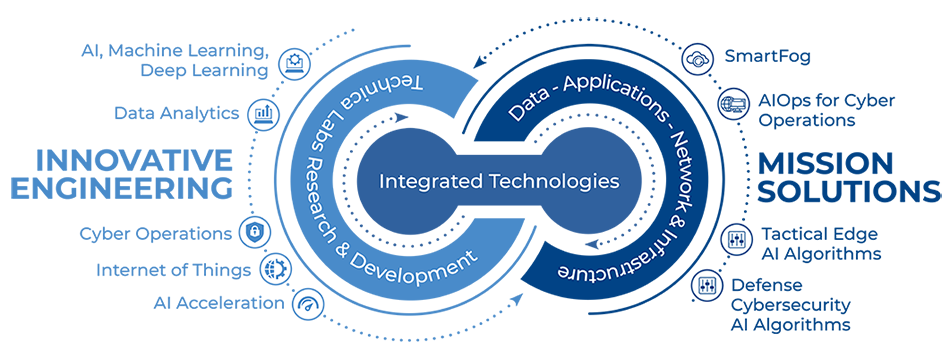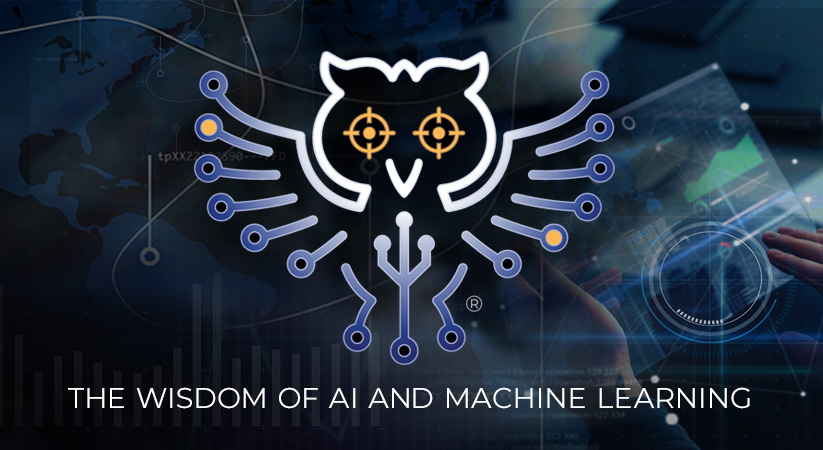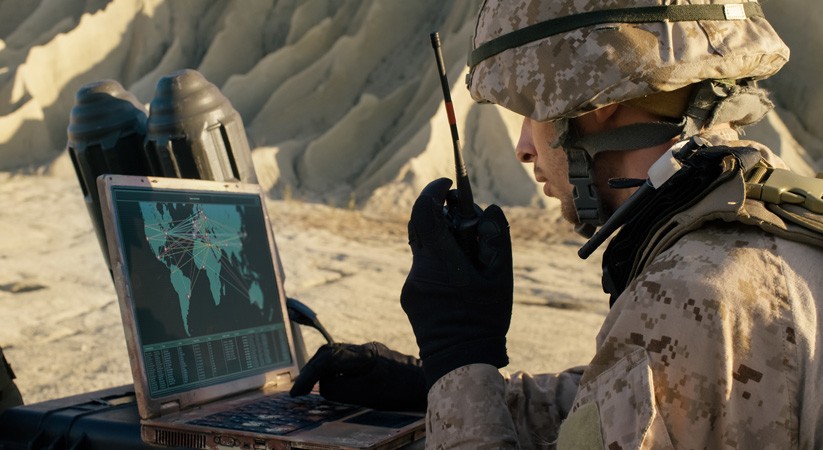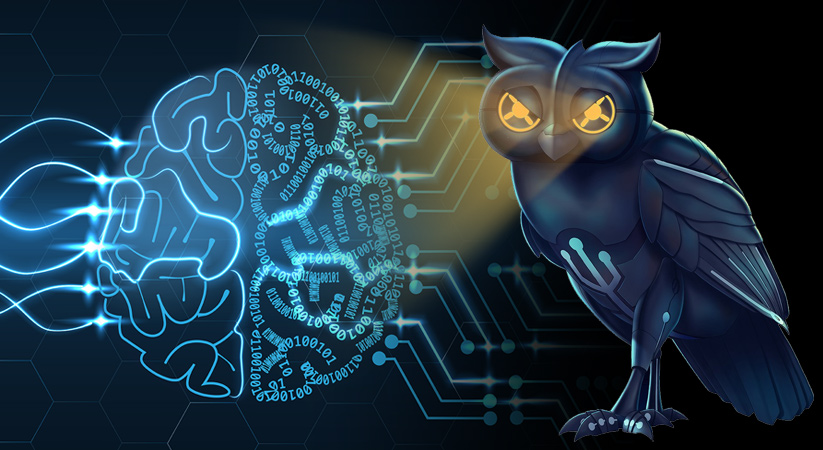Your challenges are unique. So are our solutions.
For us, it’s not just about engineering and expertise. It’s our creativity and innovation that enable us to deliver what no one else can. In our engineering (IR&D) lab, we break down every challenge to apply the smartest possible solution – and if that solution doesn’t exist, we’ll build one. We work alongside industry-leading partners as consultants by procuring hardware and software, conducting installations, managing maintenance, development of disaster recovery plans and scheduling repairs to deliver proven, scalable solutions. And, we’ve got our fingers on the pulse of trending and cutting-edge technology so we can move at the speed of inspiration.
Continuous Innovation Model

Innovative Engineering
Innovation requires investment and Technica devotes significant resources to support our own Independent Research and Development Lab, providing technical vision three or more years into the future. We are dedicated to pragmatic and holistic approaches to problem solving that are nimble enough to respond to ever-changing client needs.
AI, Machine Learning, Deep Learning
Technica has developed and used a variety of machine learning algorithms—including deep learning/neural networks—on a spectrum of computing platforms to perform complex tasks like image recognition, anomaly detection, and time-series analysis. Probably no other technology will have a bigger impact on IT than AI in the next decade.
Data Analytics
Technica employs next-generation architectures and methods to derive meaning and value from massive datasets. Our solutions incorporate vendor and open source products and Technica developed IP for best-of-breed analytic insight. Utilize next-generation methods to derive meaning from datasets that are too large for traditional SQL databases.
Cyber Operations
Technica has developed in-depth knowledge of cyber defense from operating some of the Federal Government’s largest networks. By combining the power of AI and deep learning in innovative cyber solutions, we stay on the forefront of the battle for cyber supremacy. Next-generation cybersecurity must integrate a defense-in-depth approach leveraging the power of AI and incorporating the cloud.
Internet of Things
Technica’s expertise in Edge and Fog computing helps propel advanced IoT architectures that support faster, more effective solutions for security, data analytics, and AI in compromised or disconnected environments, enabling near or real time use of information to make informed decisions at the edge. Data and insights generated from IoT will impact vast swaths of enterprise computing.
AI Acceleration
Capitalizing on the benefits of parallel processing to dramatically improve total application performance and increase solution affordability and scalability. The parallel programming capabilities offered by GPUs is a game-changer, especially in AI and ML.
Professional Services
We continuously evaluate emerging technologies to deliver exceptional solutions

DATA
APPLICATIONS
NETWORK INFRASTRUCTURE
Technica Labs
Technica provides lab facilities in conjunction with industry partners at our Dulles, Virginia corporate headquarters. Our in-house lab enables engineering staff to dynamically build out capabilities and solutions for government customers including proof of concept (POC) demonstration, penetration testing, feasibility determination, cross-platform integration and solution validation.
The equipment racks in the lab are configured on separate IP subnets and divided into three focus areas:

The Lab is a climate-controlled data center with restricted physical access controlled by a badging system to ensure a secure environment.
Lab Clients
Lab Services
Lab Focus Areas
Mission Solutions
SmartFog
Problem to solve: AI to the tactical Edge, including the ability to mitigate D-DIL communications.
Technica Solution: SmartFog is a software-based, hardware agnostic, IoT reference architecture. SmartFog marries Fog Computing with DevOPs tools to create, deploy and run SmartFog Microservices. SmartFog’s design paradigm operates similarly to the deployment of apps to smartphones. SmartFog allows you to automatically manage SmartFog Microservices - from the Cloud to the Edge.
Use SmartFog to:
- Operate effectively on the tactical Edge, in areas of disadvantaged communications
- Deliver AI to the Edge, without an “always on connection” to the cloud
- Decrease latency of computing and analytics to the Edge
- Enhance data security and privacy
Anomaly Detection & Federated Learning
Technica Corporation has developed a SmartFog Microservices Catalog for AI. Technica’s AI algorithms, based on machine learning (ML) and deep learning (DL), learn from big data to make real-time and time-sensitive decisions. Compute within the Fog Nodes allows data processing required for AI to be performed closer to the Edge, without encountering the latency of the cloud or for use cases in which cloud connectivity is intermittent to non-existent.
With the Anomaly Detection Microservice, Technica utilized GPU acceleration to develop and train artificial neural networks (ANNs) to recognize outliers that do not conform to an expected behavior. In other words, anomaly detection helps to discover “rare” events, especially those that should not have happened. The Anomaly Detection Microservice can be trained to spot anomalies in network traffic, radio signals, IoT sensor data, etc.
Additionally, Technica has advanced a model for the training of DL algorithms that reduce the need for network bandwidth—Federated Learning. With Federated Learning, a single merged DL model can be utilized without all the Fog Nodes and IoT devices requiring visibility into all the data. Additionally, this means that DL algorithms can operate in areas of disadvantaged communications. In other words, you do not need access to the cloud to leverage DL algorithms.

The current SmartFog Microservices catalog includes:
AI Analytic Microservices
- Deep Learning algorithms with configurable Federated Learning
- Fall Detection - Convolutional Neural Network (CNN)
- Image Classification - CNN
- Time-series Analysis - Recurrent Neural Network (RNN)
- Long Short Term Memory (LSTM)
- Anomaly Detection – Autoencoder
- Blind Modulation Classification (BMC)
- Beginning work with Generative Adversarial Network (GANs) and Reinforcement Learning
- Genetic algorithms to tune hyperparameters (currently applied to time-series analysis but can be extended)
System-Level Microservices
- Complex Event Processing (CEP), e.g., raise an alarm when an anomaly is detected
- MQTT Message Broker, allowing IoT devices to listen for specific messages
- Machine learning database, e.g., perform time-series analysis
- Data Transformer; e.g., binary data transformed to JSON
As use cases expand, Technica will prototype other microservices that benefit from the Fog Computing architecture and SmartFog platform.
AIOps Can be a Game Changer
But Real AIOps Success Requires a Skilled, Experienced Provider
Having too much data is not much different than having too little, or even none at all. The result can be a kind of organizational paralysis that jeopardizes mission success.
Facing — and conquering — the challenge of data-overload is something that information technology (IT) leadership in the U.S. Department of Defense and in other federal agencies knows very well.
But it gets tougher every year.
Data + Data = More Data
The sheer volume, variability, complexity and velocity of telemetry data that IT leadership and teams within DoD and the Federal Government are tasked with monitoring, processing, analyzing and managing keeps expanding — and expanding again.
With dynamics like that, even the best-equipped, most highly motivated IT personnel and teams can feel like they’re at a breaking point. So where we do go from here?
The answer is AIOps — the application of artificial intelligence (AI) and machine learning (ML) to IT operations data to improve observability, automation, and forecasting in ways that help deliver secure, reliable, high performance IT services.
A Game Changer
AIOps is a game changer for IT leadership and teams within DoD and federal agencies alike – providing actionable insights that improve the agility, accuracy, and efficiency of IT operations. According to Gartner, there is no future of IT Operations that does not include AIOps.
However, it’s also important to understand that, as powerful and effective as it can be, AIOps is not a magic wand, a silver bullet, or a cure-all. It takes a skilled solution provider to align mission objectives with analytics provided through AIOps to deliver the highest value.
The Technica Approach to AIOps
At Technica, we provide AIOps solutions and/or services, tailored to customers’ specific needs, goals, and operational realities to deliver value-focused capabilities.
Your mission, goals and operational realities, no doubt, have some things in common with other federal entities, but they’re likely to have a higher number of characteristics that are unique to your organization. AIOps not only recognizes this reality, it thrives on it.
Effectively deployed, with a true understanding of a client’s mission and operational realities, our approach to AIOps will make the data across the sprawl of management applications more effective, makes brittle point-to-point integrations nimble, and facilitates intelligent automation for proactive operations. AIOps eliminates clutter, data duplication and noise, and maintenance headaches.
AIOps Value to IT Operations
Discover and act on meaningful insights to run more efficient operations, make better decisions, and support business productivity.

Bridging Silos of Operations
Where there were once silos, AIOps builds bridges to those and connects them to others with whom you want to interact.
This approach makes it possible to discover and act on meaningful insights to run more efficient operations, make better decisions, increase overall productivity, and enables federal agencies to be more predictive of future utilization of resources and capacity.
Our work centers on crafting a utility-based data infrastructure wherein every application has a single outlet that a data provider and consumer can plug into. The data utility infrastructure handles all the translation and scales independently of the data consumers and providers, enabling agility and flexibility as IT solutions and services evolve. Ultimately, customers want to be able to shield their AIOps platform from changes that may occur in other layers — and Technica’s AIOps solution delivers that, every time.
However, achieving that requires a provider who thinks not just about the universe of data that must be managed, but equally about the data pipelines that deliver it. In summary: AI technology is important, but the data pipeline – and understanding how the data is acquired – is just as important.

